
Goal: Explore options for forming adverb clauses
Note: These dependent clauses differ from others in that they are not embedded in the matrix clause.
Tip: Consider options such as subordinating conjunctions, placement, and word order.
Work focus: Learn/Brainstorm/Try
Today’s goal is to explore options for forming adverb clauses. These are a type of dependent clause—they tend to occur with a matrix clause, add information such as time, manner, or place. Unlike other dependent clauses, though, adverb clauses are generally not embedded in the matrix clause. Not being embedded means adverb clauses tend to be more variable in their placement relative to the matrix clause, occurring before, after, or even within the matrix clause structure.
For example, in English, you can use any of these three adverb clause placements:
- before: “After they ate snacks, the children played a new game.”
- after: “The children played a new game after they ate snacks.”
- within: “The children, after they ate snacks, played a new game.”
As you explore options, consider the kinds of subordinating conjunctions you may want to create (and their placement within the adverb clause structure), word order of adverb clauses, and adverb clause placement relative to features of the matrix clause.
